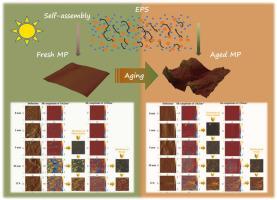Journal of Hazardous Materials ( IF 12.2 ) Pub Date : 2022-08-13 , DOI: 10.1016/j.jhazmat.2022.129773 Shuyan Xu 1 , Caiqin Wang 1 , Pengfeng Zhu 1 , Daoyong Zhang 1 , Xiangliang Pan 1

|
Environmental behavior and ecotoxicity of microplastics (MPs) are significantly influenced by the omnipresent self-assembly of microbial extracellular polymeric substances (EPS) on them. However, mechanisms of EPS self-assembly onto MPs at nanoscale resolution and effects of aging are unclear. For the first time, temporospatial nano-heterogeneity of self-assembly of EPS onto fresh and one-year aged polypropylene (PP) MPs were investigated by atomic-force-microscopy-infrared-spectroscopy (AFM-IR). Natural aging caused high degree nanoscale fragmentation of MPs physically and chemically. Self-assembly of EPS on MPs was aging-dependent. Polysaccharides were assembled on MP surface faster than proteins. Initially, regardless of the fresh or aged MPs, polysaccharides and proteins, with the former being predominant, were successively and separately assembled to different nanospaces because of their competition for binding sites. More and more proteins and polysaccharides were superimposed on each other with assembly time due to intermolecular forces. The nanochemical textural analysis showed that the nano-heterogeneity of EPS assembly to MPs was clearly correlated with the aging-induced nanochemical and nanomechanical heterogeneity of MP surface. The spontaneous self-assembly of EPS with temporospatial nano-heterogeneity on MPs have multiple impacts on behavior, ecotoxicity and fate of MPs and their associated pollutants as well as other key ecological processes in aquatic environment.
中文翻译:

细胞外聚合物自组装对微塑料和水环境影响的时空纳米异质性
微塑料 (MPs) 的环境行为和生态毒性受到微生物胞外聚合物 (EPS) 无处不在的自组装的显着影响。然而,EPS在纳米级分辨率下自组装到MP上的机制和老化的影响尚不清楚。首次通过原子力显微镜红外光谱 (AFM-IR) 研究 EPS 自组装到新鲜和一年老化聚丙烯 (PP) MPs 上的时空纳米异质性。自然老化导致 MPs 在物理和化学上的高度纳米级碎裂。MPs 上 EPS 的自组装与老化有关。多糖在 MP 表面上的组装速度比蛋白质快。最初,无论是新鲜的还是陈年的 MPs,多糖和蛋白质,前者占主导地位,由于它们对结合位点的竞争,它们被连续且分别组装到不同的纳米空间中。由于分子间的作用力,越来越多的蛋白质和多糖随着组装时间而相互叠加。纳米化学结构分析表明,EPS组装到MPs的纳米异质性与老化引起的MP表面的纳米化学和纳米机械异质性明显相关。具有时空纳米异质性的EPS在MPs上的自发自组装对MPs及其相关污染物的行为、生态毒性和归宿以及水环境中的其他关键生态过程具有多重影响。由于分子间的作用力,越来越多的蛋白质和多糖随着组装时间而相互叠加。纳米化学结构分析表明,EPS组装到MPs的纳米异质性与老化引起的MP表面的纳米化学和纳米机械异质性明显相关。具有时空纳米异质性的EPS在MPs上的自发自组装对MPs及其相关污染物的行为、生态毒性和归宿以及水环境中的其他关键生态过程具有多重影响。由于分子间的作用力,越来越多的蛋白质和多糖随着组装时间而相互叠加。纳米化学结构分析表明,EPS组装到MPs的纳米异质性与老化引起的MP表面的纳米化学和纳米机械异质性明显相关。具有时空纳米异质性的EPS在MPs上的自发自组装对MPs及其相关污染物的行为、生态毒性和归宿以及水环境中的其他关键生态过程具有多重影响。











































 京公网安备 11010802027423号
京公网安备 11010802027423号